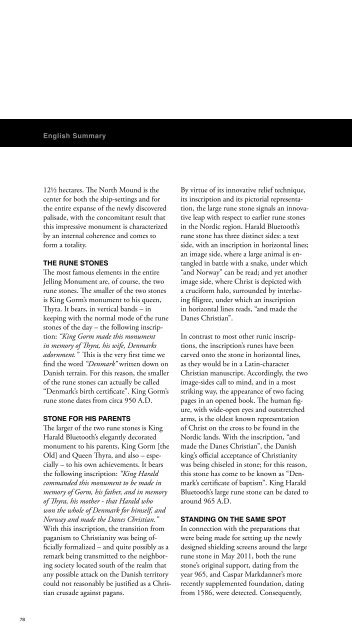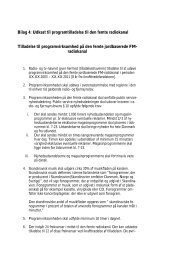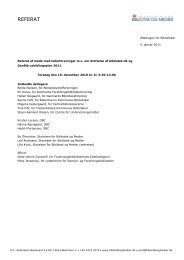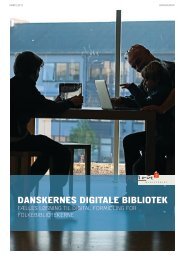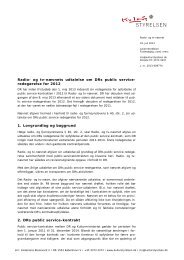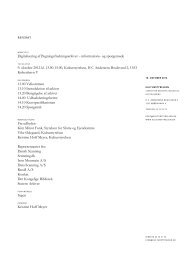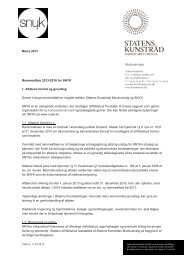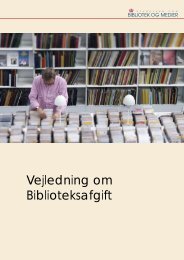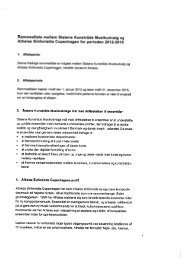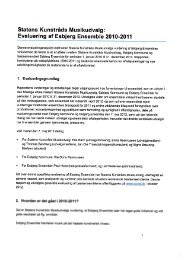"Jelling-monumenterne - deres historie og bevaring" (pdf)
"Jelling-monumenterne - deres historie og bevaring" (pdf)
"Jelling-monumenterne - deres historie og bevaring" (pdf)
You also want an ePaper? Increase the reach of your titles
YUMPU automatically turns print PDFs into web optimized ePapers that Google loves.
English Summary<br />
12½ hectares. The North Mound is the<br />
center for both the ship-settings and for<br />
the entire expanse of the newly discovered<br />
palisade, with the concomitant result that<br />
this impressive monument is characterized<br />
by an internal coherence and comes to<br />
form a totality.<br />
THE RUNE STONES<br />
The most famous elements in the entire<br />
<strong>Jelling</strong> Monument are, of course, the two<br />
rune stones. The smaller of the two stones<br />
is King Gorm’s monument to his queen,<br />
Thyra. It bears, in vertical bands – in<br />
keeping with the normal mode of the rune<br />
stones of the day – the following inscription:<br />
“King Gorm made this monument<br />
in memory of Thyra, his wife, Denmarks<br />
adornment.” This is the very first time we<br />
find the word “Denmark” written down on<br />
Danish terrain. For this reason, the smaller<br />
of the rune stones can actually be called<br />
“Denmark’s birth certificate”. King Gorm’s<br />
rune stone dates from circa 950 A.D.<br />
STONE FOR HIS PARENTS<br />
The larger of the two rune stones is King<br />
Harald Bluetooth’s elegantly decorated<br />
monument to his parents, King Gorm [the<br />
Old] and Queen Thyra, and also – especially<br />
– to his own achievements. It bears<br />
the following inscription: “King Harald<br />
commanded this monument to be made in<br />
memory of Gorm, his father, and in memory<br />
of Thyra, his mother - that Harald who<br />
won the whole of Denmark for himself, and<br />
Norway and made the Danes Christian.”<br />
With this inscription, the transition from<br />
paganism to Christianity was being officially<br />
formalized – and quite possibly as a<br />
remark being transmitted to the neighboring<br />
society located south of the realm that<br />
any possible attack on the Danish territory<br />
could not reasonably be justified as a Christian<br />
crusade against pagans.<br />
By virtue of its innovative relief technique,<br />
its inscription and its pictorial representation,<br />
the large rune stone signals an innovative<br />
leap with respect to earlier rune stones<br />
in the Nordic region. Harald Bluetooth’s<br />
rune stone has three distinct sides: a text<br />
side, with an inscription in horizontal lines;<br />
an image side, where a large animal is entangled<br />
in battle with a snake, under which<br />
“and Norway” can be read; and yet another<br />
image side, where Christ is depicted with<br />
a cruciform halo, surrounded by interlacing<br />
filigree, under which an inscription<br />
in horizontal lines reads, “and made the<br />
Danes Christian”.<br />
In contrast to most other runic inscriptions,<br />
the inscription’s runes have been<br />
carved onto the stone in horizontal lines,<br />
as they would be in a Latin-character<br />
Christian manuscript. Accordingly, the two<br />
image-sides call to mind, and in a most<br />
striking way, the appearance of two facing<br />
pages in an opened book. The human figure,<br />
with wide-open eyes and outstretched<br />
arms, is the oldest known representation<br />
of Christ on the cross to be found in the<br />
Nordic lands. With the inscription, “and<br />
made the Danes Christian”, the Danish<br />
king’s official acceptance of Christianity<br />
was being chiseled in stone; for this reason,<br />
this stone has come to be known as “Denmark’s<br />
certificate of baptism”. King Harald<br />
Bluetooth’s large rune stone can be dated to<br />
around 965 A.D.<br />
STANDING ON THE SAME SPOT<br />
In connection with the preparations that<br />
were being made for setting up the newly<br />
designed shielding screens around the large<br />
rune stone in May 2011, both the rune<br />
stone’s original support, dating from the<br />
year 965, and Caspar Markdanner’s more<br />
recently supplemented foundation, dating<br />
from 1586, were detected. Consequently,<br />
it has been substantiated once again that<br />
this rune stone is still standing on the<br />
same spot where it was erected more than<br />
a thousand years ago. On the other hand,<br />
the original placement of the smaller rune<br />
stone is not known. In a manuscript dating<br />
from around 1600, it is mentioned that the<br />
smaller rune stone was placed close to the<br />
church door, where it was used as a bench.<br />
It can be ascertained, however, that the<br />
smaller rune stone was placed on the spot it<br />
presently occupies sometime between 1627<br />
and 1639.<br />
THE STONES’ CONDITION<br />
Since 1823 there has been a growing concern<br />
for the condition of the rune stones.<br />
In the years 2006-2008, The National Museum<br />
of Denmark conducted a study of the<br />
rune stones’ condition. The study revealed<br />
that, on both of the stones, there were<br />
blown-off spallings and areas with hollow<br />
spaces inside the stones. On the smaller<br />
rune stone in particular, it was found that<br />
there was a cavity of approximately 1500<br />
cm2, which touched upon significant portions<br />
of the rune stone’s inscription band.<br />
It could be also ascertained that a small<br />
area had disappeared sometime after 1984.<br />
The total surface area of the large rune<br />
stone is approximately 12 m 2 . Here, it was<br />
established that blown-off spallings constitute<br />
approximately 1.6 m 2 of the stone’s<br />
aggregate surface. Also on the large rune<br />
stone, it was ascertained that there were<br />
areas with cavities beneath approximately<br />
270 cm 2 of the stone’s embellished surface.<br />
CONTROLLED CLIMATE<br />
The condition of the two rune stones was<br />
deemed extremely critical. Pursuant to a<br />
dial<strong>og</strong>ue with UNESCO’s World Heritage<br />
Centre in Paris, The Heritage Agency of<br />
Denmark arrived at a determination that<br />
from now on the rune stones would have to<br />
be preserved inside of a controlled climate.<br />
The effects of moisture (rain, snow, f<strong>og</strong> and<br />
condensation) and frost as well as the risk<br />
of physical injury to the stones would have<br />
to be warded off so as to prevent the emergence<br />
of any more cracks and splits in the<br />
stones and any further damage or deterioration<br />
to the inscriptions and the pictorial<br />
surfaces. Seeing as the large rune stone is<br />
standing today on the very same spot as<br />
when it was raised more than 1,000 years<br />
ago, it was deemed crucial to bring about a<br />
controlled climate around the rune stones<br />
without them having to be moved so that<br />
the authenticity in the entire monument in<br />
<strong>Jelling</strong> would be preserved intact.<br />
COMPETION<br />
On the basis of this, The Heritage Agency<br />
of Denmark arranged an open ideas competition<br />
centered on generating proposals<br />
for the design of a climate-controlled<br />
protective-screening around the <strong>Jelling</strong><br />
Stones.<br />
There were 157 proposals submitted, including<br />
a number from abroad. As the first<br />
prize winner, the jury unanimously selected<br />
a proposal by NOBEL architects. With a<br />
donation from the Velux Foundation and<br />
an additional grant from the Ministry of<br />
Culture, the project was realized in 2011.<br />
THE INTEREST IN JELLING<br />
Four hundred years ago, interest in the<br />
monuments in <strong>Jelling</strong> was awakened and<br />
studies were commissioned. In the year<br />
1586, Caspar Markdanner, King Frederik<br />
II’s lord lieutenant at Koldinghus Castle,<br />
raised the large rune stone to an upright<br />
position so that its honor and dignity<br />
would be restored. In 1704, the first excavations<br />
in the North Mound were carried<br />
out. In 1820, the local farmers discovered<br />
a burial chamber in the North Mound and<br />
78 79


